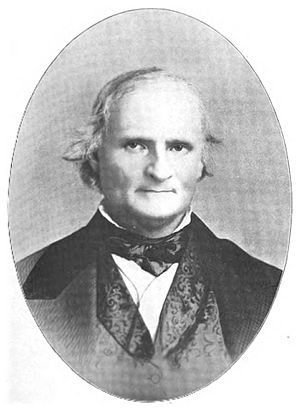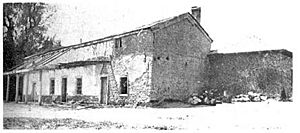Louis Rubidoux facts for kids
Quick facts for kids
Louis Rubidoux
|
|
|---|---|
 |
|
| Born | 1796 |
| Died | 1868 |
| Nationality | American |
| Other names | Louis Robidoux |
| Occupation | Rancher, Politician |
| Known for | Founder of Rubidoux, California |
| Louis Rubidoux Home | |
|---|---|

Louis Rubidoux Home in 1897
|
|
| Location | 5575 block, Mission Blvd, Rubidoux, California |
| Built | 1897 |
| Designated | March 29, 1933 |
| Reference no. | 102 |
| Lua error in Module:Location_map at line 420: attempt to index field 'wikibase' (a nil value). | |
| Rubidoux Grist Mill | |
|---|---|
| Location | Rubidoux, California |
| Built | 1846 |
| Designated | September 12, 1939 |
| Reference no. | 303 |
Louis Rubidoux (1796–1868) was an important early settler in what is now Riverside, California, in the United States. He was born as Louis Robidoux.
Louis Rubidoux arrived in California in 1844. He became a very successful rancher. He bought large areas of land, including parts of the Rancho Jurupa. He built the first grist mill (a mill for grinding grain) in the area. He also ran a winery. Louis Rubidoux was one of the first leaders in San Bernardino County. The town of Rubidoux and Mount Rubidoux are named after him.
Contents
About Louis Rubidoux
Louis Rubidoux was born in St. Louis, Missouri, on July 7, 1796. When he was younger, Louis worked as a fur trapper and mountain man in New Mexico. He traveled often between New Mexico and California. He traded blankets from New Mexico for horses from California.
In 1844, Louis Rubidoux finally settled in California. He came with his wife and their baby daughter. They lived near a place called Agua Mansa, which is close to modern-day Colton. Another fur trapper, Benjamin Davis Wilson, had also moved to California from New Mexico a few years earlier.
Louis Rubidoux later moved further west. He settled in the area near Riverside that now carries his name.
Rubidoux and the U.S.-Mexican War
Louis Rubidoux was involved in the U.S.-Mexican War. In a letter he wrote in 1846, he called himself a "prisoner of war."
After General Stephen Watts Kearny took control of Santa Fe in August 1846, Rubidoux and his neighbor Benjamin Wilson met with other foreigners. They planned to go to Los Angeles to join the American forces there.
However, on September 27, a Mexican army officer named Jose Maria Flores attacked them. Rubidoux and his group were gathered in a house that was set on fire. After fighting for an hour, they surrendered to avoid being burned alive. Rubidoux wrote, "From that moment I lost my liberty."
The prisoners were told to decide what would happen to their property and families. They were afraid they might be sent to Mexico City as prisoners. However, another Mexican group convinced Officer Flores not to send them away. The prisoners eventually paid to be set free.
In January 1847, American forces won two battles. Rubidoux and his companions were freed on January 10. A peace treaty was then signed, which was seen as fair to the people of California.
Family Life
Louis Rubidoux married Guadalupe Garcie in 1834. Guadalupe came from an important family in New Mexico. Louis and Guadalupe had a large family with at least nine children.
Louis Rubidoux passed away on September 24, 1868. He is buried in the Agua Mansa Pioneer Cemetery in Colton, California.
California Historical Landmarks
The places where Louis Rubidoux lived and worked are now recognized as California Historical Landmarks.
Louis Rubidoux House
- NO. 102 SITE OF LOUIS RUBIDOUX HOUSE - In 1844, Louis Rubidoux came to California with his family. Soon after, he bought the Jurupa Rancho. He became one of the most successful ranchers in Southern California. He also planted fruit trees and vineyards, grew grain, built the first grist mill in the area, and ran a winery.
Old Rubidoux Grist Mill
- NO. 3O3 SITE OF OLD RUBIDOUX GRIST MILL - One of the first grist mills in this part of Southern California was built by Louis Rubidoux on the Rancho Jurupa in 1846-47. This mill was very important because it was the only one of its kind there. Louis Rubidoux was a pioneer builder and one of the first American citizens to live permanently in the valley.
Other Places Named After Him
The Louis Robidoux Nature Center in Jurupa Valley was named in his honor. This center was closed in 2017. Plans were made to reopen it, but it was sadly destroyed by a fire in October 2019.

